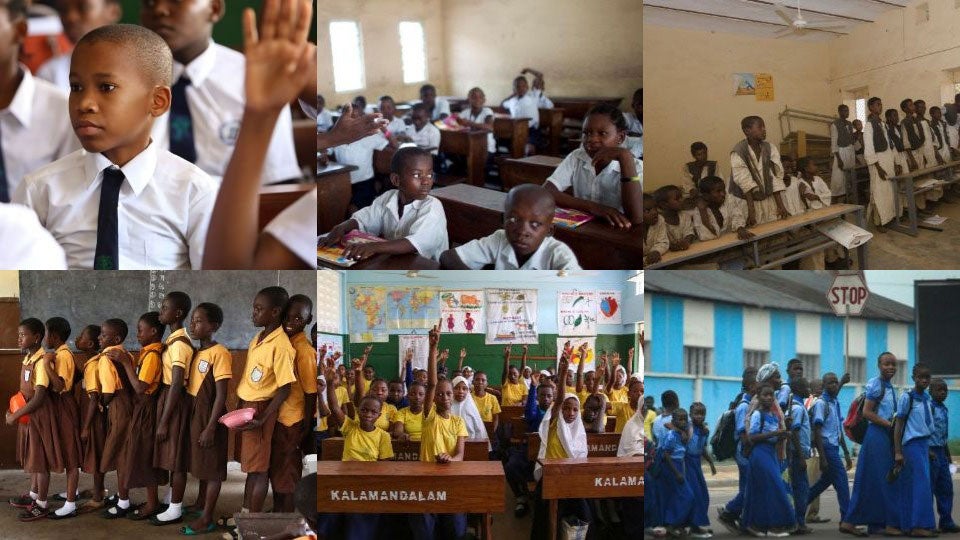
Around much of Africa, children wear uniforms to school. With the abolition of official school fees for primary school in most countries, the cost of uniforms can be one of the largest expenses for families. In a new study, we examine the impact of providing free school uniforms to primary school children and observe how it affects their school participation in the short and long run.
Why would you want to make children wear school uniforms, anyway?
With controversy about policing students’ clothing from the U.S. to Zambia, one might question the wisdom of requiring school uniforms in the first place. But there are various arguments in favor of uniforms:
- School uniforms mean that students aren’t competing in their attire, so hopefully more attention stays on their studies. Uniforms can downplay economic differences between students that would otherwise be more apparent.
- School uniforms can instill a feeling of community among students.
- Through the increased sense of community and the reduced salience of economic inequality, uniforms could improve discipline.
- School uniforms may make it easier to identify unauthorized visitors to the school.
- School uniforms reduce the time students spend deciding what to wear, allowing more time for sleeping or studying.
Of course, there are also potential downsides. Uniforms restrict students’ opportunity to express themselves. Most importantly, school uniforms will not solve the most fundamental challenges with quality education.
But the question we ask is, in countries where school uniforms are the norm – as in many African countries – does providing them for free help children to stay in school?
What happened when students received free school uniforms in Kenya?
A non-governmental organization (NGO) in rural western Kenya provided uniforms to primary school children over the course of several years. (This was a child sponsorship program, but in this case, the main individual benefit that children received was a school uniform.) Because they had limited uniforms, the NGO provided uniforms to all orphans, and then they used a lottery to decide which of the remaining children in the first years of primary school would receive a uniform. We use the lottery to compare children who “won” a school uniform to those that did not, to see whether it helped them to stay in school.
School absenteeism in these schools was about 20%. That might sound low, but it means that the average child was missing one day of school every week. Providing free school uniforms decreased absenteeism to 13% in the initial years of the program. That means that providing school uniforms cut absenteeism by 37%. For the poorest children, the effects were even bigger. Absenteeism fell by more than half for those students who had no uniform at the outset of the program.
Of course, the ultimate goal of keeping students in school is that they learn more, get further in school, and go on to get better jobs and have better lives. To see if this came about, we returned to the same schools eight years later to see if the children who received uniforms were better off than other children. The result? No clear pattern of long-term effects. School uniforms made a dent in school absenteeism, but they weren’t enough – by themselves – to change the long-term path for these children.
What have other studies that provided school uniforms found?
While our paper may be the first to look at longer term impacts of providing school uniforms, several studies have examined shorter term effects. Here’s what they found.
- Another intervention in Kenya provided “two free school uniforms over the last three years of primary school.” It resulted in reduced dropouts for both boys and girls and even reduced the teen pregnancy rate. And yet another intervention in Kenya, which provided a mix of benefits to households – but school uniforms were the largest component – also reduced dropout rates.
- In Ecuador, a program to distribute free school uniforms actually resulted in lower school attendance. But wait! In that case, the uniforms were announced but not actually distributed in more than a third of schools, so parents and students may have been disillusioned with the school system by an unfulfilled promise. Don’t announce free uniforms if you don’t intend to follow through!
- A government school uniform distribution program in India improved school enrollment for children from historically disadvantaged castes, but it had negative impacts for students from castes that were historically more advantaged.
The takeaway
The World Bank’s World Development Report 2018 highlights that one of the largest challenges facing countries around the world is that children are not learning as they should, even once they are in school. But many children still do not make it far enough in school, and attendance is an important element of learning. School uniforms can help children – especially the poorest children – to continue attending school. But if we want enduring impacts, the schools they attend have to deliver the learning that children deserve.



Join the Conversation